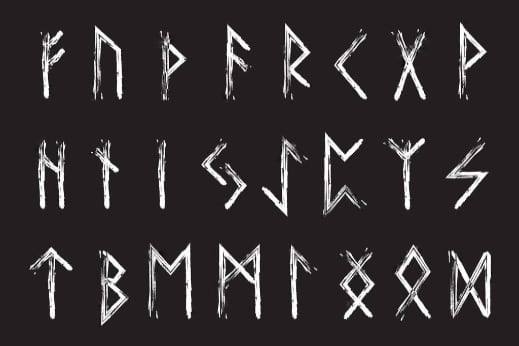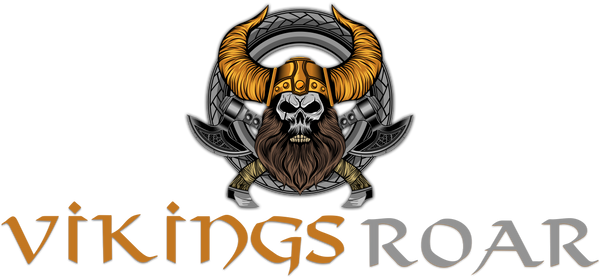
The Viking Runes: Northern Europe's Historical Writing Systems
Share
You may have heard of Scandinavia's numerous surviving runestones. The landscape of Scandinavia is filled with these beautiful monoliths with complex artwork. But how much do we really know about what they're announcing?
The Origins of Viking Runes
The precise origins of the runes used by the Germanic peoples of Northern Europe in the first millennium of the Common Era are unknown. The characters share similarities with other writing systems, but none of them line up closely enough to make a clear ‘yep, this is it' for the scholars. The runes definitely evolved from the ancient Italic scripts used on the Italian peninsula, which in turn evolved from the Greek alphabet.
It's believed they came from the Etruscan script, which evolved into the Latin alphabet, which English and most Western languages still use to some extent today. It's also up for debate how we'll get from Italy to Scandinavia! There are two theories as to how the runes first appeared in Denmark and Northern Germany.
According to the West Germanic Hypothesis, they arose from migratory populations around the Elbe River. According to the Gothic Hypothesis, they arose as a result of East Germanic expansion into territories such as modern-day Ukraine and Belarus.

What's in the name?
The rune systems are frequently referred to as 'runic alphabets,' which is a completely acceptable phrase for most people.However, the term alphabet is derived from ‘alpha beta' or ‘aleph beth,' the first two letters in the Greek and Hebrew alphabets. The runes do not begin with A and B, but with F and U, which could result in some intriguing complications!
Scholars instead call the Scandinavian runic systems a Futhark or Fuark after the first six letters: F, U, Th/, A, R, and K. If you've ever wondered where the letter (known as thorn) originates, it's from the runes.
It appears frequently in old Norse and Anglo-Saxon literature. It was eliminated from Scandinavian and English in favor of ‘th,' but it survives in Icelandic.
The term rune is derived from the Germanic word run-, which means "secret" or "whisper." In Celtic, the word has similar meanings, but in other languages, it refers to a knife cut, a speech, or a miracle. It is possible that the term refers to'secrets,' since runes were used in the beginning.

The mystical aspect of runes is frequently mentioned, however it is rarely supported by actual facts. What we do know is that runic inscriptions were normally reserved to commemorate significant events or people. This was not a common alphabet during the Viking Age.
There are numerous rune systems.
There is no single set of Viking runes in Scandinavia or abroad. Instead, the systems continued to evolve. We consider two Futharks to cover the period: Elder Futhark and Younger Futhark.There is also Anglo-Saxon Futhorc, which is a development of the Germanic tribes that moved to England during the time. It's termed a Futhorc to reflect the variations in sound that occurred throughout this time period.
Long-branch runes, Rök runes, and stavlösa or Hälsinge runes are the three types of runes in younger Futhark (also known as staveless runes). While all have been seen in the region, the long-branch is more prevalent in Denmark, while the Rök is more common in Sweden and Norway.
Futhark of the younger generation evolved into the medieval runes that followed the Viking Age. These are thought to be a reaction to the expansion of the Latin alphabet, which was opposed by many at the time.
The medieval runes are most likely the runes that people are most familiar with. In the 16th century, dalecarlian runes or dalrunes were developed, which were used in the Swedish province of Dalarna until the 20th century. Because of this. Dalarna is referred to as the "final stronghold of Germanic script."

Runes of Elder Futhark (until around 800CE)
The Viking period began with Norse still utilizing the Elder Futhark, which most closely resembled the Italic scripts from which it originated. There is also evidence that the journey was not one-way. The Greeks created the Gothic alphabet in the fourth century to interpret the Bible, and it contains two characters that can only have come from runes.
The Futhark is made up of 24 runes. Each rune most likely had a name that was picked to symbolize the rune's sound. The rune names are preserved in the Old English Rune Poem, which includes stanzas on each character as well as 5 from the Anglo-Saxon Futhorc.
The runes were typically organized in groups of eight, known as a tt or ttir. We have the following in Elder Futhark:
f u a r k g w ; h n I j ï p z s ; t b e m l o d
Several of the runes have little resemblance to the Italic alphabets and how they evolved into the Latin alphabet.
g, a, f, I t, m, and l are the same as our X, A, F, I, T, M, and L.
The letters u, r, k, h, s, b, and o are popularly thought to correlate to the letters V, R, C, H, S, B, and O.
The remaining letters could be new inventions or modifications of obsolete Latin letters.
The earliest documented sequential listing of the Futhark dates from 400CE and can be found on the Kylver Stone on Gotland.
Elder Futhark's invention has been attributed to a single person or small group. These were most likely mercenaries in the Roman army or merchants doing business in the area. Opinions differ on the original aim, but most early instances imply that the idea was a fun copy of Roman letters rather than a serious attempt at scripture.

Younger Futhark, (800-1100CE)
The Younger Futhark was the most significant development of runes in terms of Vikings. Surprisingly, while most other writing systems were developing at the period, The Younger Futhark is a streamlined and condensed system with only 16 characters. Despite the fact that the number of phonemes, or sounds, in the language kept increasing!
In contrast to the Elder Futhark, which was known and used by a small group of people, the Younger Futhark was known and used by the whole population of the region. This is shown by the fact that far more Younger Futhark have been discovered, with several of them being of a more inconsequential, almost casual nature.
The first ætt dropped the letters g and w to create f, u, th, a, r, and k.
The second tt lost the letters and p, resulting in h, n, I j, z, and s. The j sound changed to an a sound, and the z shifted location.
The third tt dropped four letters, e, n, o, and d, to form t, b, m, and l.
The successive runes
With the Christianization of Scandinavia at the conclusion of the Viking Age, the Latin alphabet was widely used in the region. But the narrative of runes does not end there. Many people were adamant about preserving Old Norse and the runic systems that composed it.

The first change was the inclusion of dots. Rather than creating new runes for the missing phenomes, they simply took existing runes and added dots to form new ones. Accents in other languages are similar in idea. The e rune is simply an I rune with a dot.
Despite the fact that medieval runes were ‘competing' with the latin alphabet used by the Christian Church, there are numerous examples of biblical inscriptions done in runes. Farmers would also continue to employ runes to mark commodities and communicate for many years.
Finally, the runes died extinct, but as previously said, they were still in use until the end of the twentieth century.
Rune interpretation
We know a lot about the runes and how they correspond to current characters. It's far more difficult to figure out exactly what they meant.Due to the compacted nature of the Younger Futhark, each character may stand for numerous sounds. It is impossible to discern which of the sounds was intended if you do not have the context. Because the I rune was used for e and I, a word like pick could signify either pick or peck.
Another issue is that as runes became obsolete – as the language evolved away from some sounds and toward others – the runes were frequently reused for a different sound. As a result, you may wind up with a system in which KAT could signify cat, hat, or bat depending on when it was written and whether the writer was up to date on new sounds.
The context of some runestones is obvious, and the translation is uncomplicated. With others, we'll never know exactly what they mean, and the most we can do is speculate.
Today's usage of Viking runes
Unfortunately, numerous of the runes have been co-opted by the far-right, particularly neo-nazis. The most notable is the Sowilo rune, which doubled as the SS's insignia. In Nazi Germany, the runes Eihwaz, Algiz, Othala, and Hagal also had unique meanings. Guido von List created the Armanen runes from runes from the Younger Futhark.Many of these runes are still used today as discreet tokens of support for far-right and neo-nazi ideology that can be worn as pendants and tattoos without drawing notice. Everyone recognizes a Swastika, but only those in the know are likely to understand the meaning of, say, the Othala rune.
Role-players and Viking or runic aficionados are actively involved in attempting to recapture the runes from these groups. Clearly, they want to be able to wear and utilize runes without the negative implications.
Runes also appear as map markers in Tolkien's The Hobbit, emphasizing their link to the dwarves. They also featured in early drafts of The Lord of the Rings before being replaced with Tolkien's own rune-like Cirth script.
The Bluetooth emblem, which may be found on millions of electrical gadgets worldwide, is a mix of the hagall and bjarkan runes. These relate to the letters H and B, which are the initials of Harald Bltan, also known as Harald Gormsson and known by the nickname Bluetooth. Harald was a king of Denmark and Norway in the Viking age.
